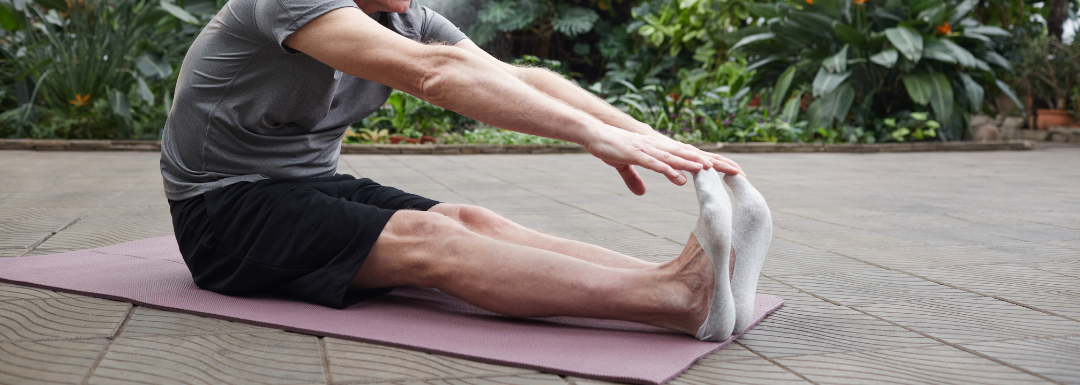Stretching was a thing when I was growing up. Going for a run? Put that leg up on a fence and stretch that hamstring. Kickboxing class starting soon? Do those side lunges and stretch that groin out. Aerobics class? Stretch everything out.
If regular exercise is important to you (I hope so!) you won’t hear much about stretching these days. Stretching has definitely become passé, like the term passé.
Putting a limb out to just beyond the comfy end of its range of motion, holding it there and trying to relax into it…doesn’t do what most of us thought it would do.
It doesn’t decrease injury risk (it does the opposite, especially if done before a workout). It doesn’t warm up the muscles (low intensity exercise does that). And it doesn’t translate well into athletic activity in the desired range (which usually demands active movement under tension at speed, the opposite of what you do when you conventionally stretch).
There is a role for passive stretching, just not for the qualities of interest.
At least, not by itself.
Gumby might be a fun date, but…
Unless your endpoint is being a contortionist — putting a limb or your spine way out there and holding that position — an expanded range of motion for its own sake has pretty limited usefulness.
Do you have to do something at the extremes of that extended range, like jump, pull hard, or hold a load steady? If you’re a first responder, or training to become Indiana Jones or Lara Croft, then increasing your range of motion is Step 1, and Step 2 is increasing your active or isometric strength throughout that range.
Does lacking that range mean that your body part will get forced into that range injuriously? Then you probably know that your motion is abnormally limited due to scar tissue or neuroprotective reflexes from previous trauma, and regaining the range plus the strength to protect the joint again become critical.
Does increasing your range increase your risk of injury, by decreasing the existing stability of the joint? If 100% motion takes a joint to the limit of what the ligaments holding it together are supposed to do, and you decide you need 105%, those ligaments may no longer be snug back at 85%. Strengthening the surrounding muscles again becomes important, as does considering what “stretching” is costing you in reduced natural stability.
If the real ask is “I don’t want to get hurt again,” stiff muscles are only one of the potential issues.
Case in point: my own BJJ return journey
Short version, my injuries happened due to the following:
- neural reflex pushing connective tissue past redline (my brain telling my muscles to contract too hard, after years of inactivity)
- insufficient connective tissue prehabilitation (not enough months for the strengthening adaptation to occur)
- weakening via insufficient recovery (too much other exercise before the main event, weakening the tissues so that their tolerances were easily exceeded)
Only one of these mechanisms involved not doing enough, and that was insufficient strengthening, not insufficient range of motion. I could always put the limb where it was supposed to go. The muscle and ligament tears happened anyway.
You absolutely need range of motion
It’s just that the range by itself isn’t enough.
How much range must you have? There are standards that a physical therapist or sports medicine physician can share with you. But these are a bit arbitrary. You can get by with significantly fewer degrees of motion than the textbooks say you should have.
The key is getting your limbs or spine in place to exert whatever force is necessary at that moment.
At its most basic, this means you moving your body relative to the world: getting your leg under you to prevent a fall, or your feet under you so you can stand up, or turning your body enough to put your hand on something to push yourself up. If you can move enough to do the fundamental human motions that we take for granted between our toddler and ancient years, you have “sufficient” basic range of motion.
Otherwise, it’s about moving something else around you: hoisting the luggage into the overhead rack, turning the steering wheel when parallel parking, or lifting the sack of groceries out of the car trunk. The more sporty these moves get, the more demanding the range of motion becomes (e.g., archery, dance, Brazilian jiu-jitsu, tennis, golf, or in an excellent sport specific YouTube video by former CrossFit athlete Marcus Filly, functional bodybuilding).
You need strength just as much
What should be immediately obvious is that getting your foot, or arm, or leg into position — having the range of motion, the flexibility, to position yourself to do either kind of movement — is not enough. If you cannot then push with sufficient force, your butt is going to stay on the floor, and that suitcase will need flight attendant assistance to make it into the overhead.
And your training partner is just going to look at you funny on the mat or in the weight room.
Hence, you’ve probably heard more about the importance of strength training, including the catchphrase “functional strength.” There are objective, arbitrary measures of sufficiency here, too, like the gym standards of a man bench pressing his body weight or deadlifting twice that. But significance depends on your situation: for fighter pilots, those standards wouldn’t mean much.
At the end of the day, what counts is Are you strong enough to do what YOU need to do?
Whatever that is will demand both flexibility and strength.

Leave a Reply